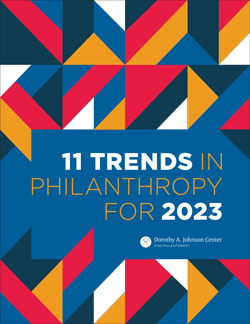New Organizational Structure Models are Toppling the Staff Pyramid


 This article was first published in our 11 Trends in Philanthropy for 2023 report. Explore all 11 trends in the report.
This article was first published in our 11 Trends in Philanthropy for 2023 report. Explore all 11 trends in the report.
Want the latest trends, research, and more delivered right to your inbox? Subscribe to the Johnson Center email newsletter.
The single-executive model has long dominated organizational structures in all three sectors: business, government, and philanthropy. Of course, examples of co-leadership and distributed leadership models have always existed, providing important foils to the default, pyramid-shaped hierarchy. However, among the many forces and values currently disrupting philanthropy, a push to reject organizational structures that are seen as overly burdensome, regressive, and even harmful is gaining ground.
“[N]onprofits are increasingly embracing non-traditional structures such as co-leadership, co- or multi-executive directorship, worker self-direction, and fiscal sponsorship as opportunities to create more sustainable and mission-driven programs.”
Today, nonprofits are increasingly embracing non-traditional structures such as co-leadership, co- or multi-executive directorship, worker self-direction, and fiscal sponsorship as opportunities to create more sustainable and mission-driven programs.
In their article, “Innovations in Talent Investment for Individuals, Organizations, and Communities,” Sharp Eizinger et al. (2022) highlighted the emerging trend of co-leadership and distributed leadership models and their benefits, such as “supporting more diverse talent and making leadership roles more sustainable” (para. 15) in an often lonely, under-resourced, and multi-hat-wearing role. This trend is flourishing.
For instance, Kathy Im (2021), director of Journalism & Media at the John D. and Catherine T. MacArthur Foundation, reported on the proliferation of co-leadership models among grantee partners in “Reimagining Nonprofit Leadership Models.” Im named half a dozen organizations with two or more executive directors, also writing that “we notice that leaders who are not bound by traditional notions of organizational structure are also more likely to be empathetic and proactive about the mental health and personal well-being of leaders and staff” (para. 8).
The Bridgespan Group also interviewed three organizations that had adopted a co-leadership model to better understand their experiences: Catholic Family Service in Alberta, Canada; East Yard Communities for Environmental Justice in Commerce, California; and ProInspire in Washington, D.C. Bridgespan shared their findings in March 2022, revealing these organizations’ desire for collaboration, skill-sharing, and power-sharing, all in concert with their values (Chary).
Camille Kerr (2022) explained, “In a worker cooperative, democracy is baked into the model. Worker co-ops are structured in such a way that each worker-owner has an equal vote, and they directly choose—and serve on—the governing board” (para. 5). This structure eschews traditional workplace roles, hierarchies, and systems of decision-making in favor of something better aligned with the solidarity economy. “Movement builders,” wrote Kerr, “are developing worker cooperatives as living examples of what a reimagined economy based in mutual care can look like” (2022, para. 3).
The Sustainable Economies Law Center (SELC) in Oakland, California, launched as a worker self-directed nonprofit in 2009. Their policies include a decentralized governance where “Each program is run by a semi-autonomous circle of staff and volunteers, nested within larger circles of accountability. Our decision-making processes enable each staff member to propose projects and take significant leadership roles, optimizing individual autonomy and collective responsibility” (n.d.a, para. 6).
Thanks to clamoring interest in their model, SELC hosted multi-day convenings in 2017 and 2019, to introduce nonprofits to worker self-direction. Those programs spawned the Nonprofit Democracy Network for like-minded organizations. The network offers training, peer connection, and network building for nonprofits looking to adopt or launch a worker-ownership model (n.d.b).
In Michigan, after restructuring to a low-profit limited liability company in 2016, Data Driven Detroit (D3) spent nearly six more years exploring the worker-owned model and developing a plan for implementation. D3 transitioned to a fully worker-owned cooperative in 2022. According to their website (2022), “This structure allows us to better live out and preserve D3’s values in day-to-day operations” (para. 6).
The Nonprofit Democracy Network is a fiscally sponsored program of SELC. Fiscal sponsorship is another structural alternative that can substantially lessen an organization’s administrative burden. In such a relationship, programs, initiatives, and whole organizations can operate under the tax status of another organization, utilizing as much of that organization’s administrative and programmatic support as the two parties agree to. A 2021 report from New Venture Fund also points out how fiscal sponsors can support racial equity by serving as critical intermediaries.
Social Impact Commons (SIC), launched in 2019 as the first national infrastructure group devoted to advancing the fiscal sponsorship model, estimates that there are at least 600 to 1,000 fiscal sponsors operating in the U.S., and likely many more (T. Squire, personal communication, November 4, 2022). So, while it’s impossible to say for certain whether the incidence of fiscal sponsorship is growing, it is possible to say that interest surely is. Also, according to SIC, attendance at the annual conference of the National Network of Fiscal Sponsors has been growing 20–30% year over year for the last decade.
Bridgespan’s case study (2022) noted why these models are gaining traction now: “… the pandemic has pushed–and allowed–nonprofits to experiment with new ways of working; to consider new ways to share power and to center proximate Black, Indigenous and people of color (BIPOC) leaders; and to focus on succession planning more intentionally in innovative ways in response to the ‘great resignation’” (Chara, para. 3).
In our research for this article, it became clear that many other factors are contributing to the change, as well. Organizations adopting these new models all have their reasons; some are unique, but many echo one another.
Disrupting the cycle of burnout. The executive director role is notoriously lonely, with individual leaders frequently called upon to be all things to all people. Dividing up the responsibilities of a single position across many people or roles can ease the mental, emotional, and workload burden so that leadership becomes more sustainable and rooted in both skill and experience.
Advancing Diversity, Equity, and Inclusion (DEI). Michael Courville, Natalie Blackmur, and Michael Arnold of Open Mind Consulting (2019) asked the important question, “Is there a relationship between organizations’ efforts to be more diverse, equitable, and inclusive, and the practices and cultural orientation required of distributed leadership?” (para. 2).
Many nonprofit practitioners are embracing these new organizational models as a means of advancing DEI goals. Creating new leadership roles within an organization automatically means there are more such roles available in the field; new leaders do not have to wait for current leaders to leave their positions.
In each example provided, the key to successfully transitioning from a traditional, single-executive model to a new organizational chapter seems to be two-fold: both preparation and ongoing learning and evolution are essential. Whether this trend drives a larger evolution in the field of philanthropy remains to be seen.


Chary, M. (2022, March 23). Three nonprofits share their approaches to co-leadership. The Bridgespan Group. https://www.bridgespan.org/insights/library/leadership-development/approaches-to-nonprofit-co-leadership
Courville, M., Blackmur, N., & Arnold, M. (2019, August 8). What’s next in our exploration of distributed leadership? Open Mind Consulting. http://www.omconsult.org/blog/2019/8/8/whats-next-in-our-exploration-of-distributed-leadership
Data Driven Detroit. (2022, February 9). Why worker ownership. https://datadrivendetroit.org/blog/2022/02/09/why-worker-ownership/
Im, K. K. (2021, December 21). Reimagining nonprofit leadership models. MacArthur Foundation. https://www.macfound.org/press/perspectives/reimagining-nonprofit-leadership-models
Kerr, C. (2022, September 7). The transformative power of worker ownership. Nonprofit Quarterly. https://nonprofitquarterly.org/the-transformative-power-of-worker-ownership/
New Venture Fund. (2021, June). Leveraging fiscal sponsorship for racial equity. https://newventurefund.org/wp-content/uploads/2021/09/Leveraging_Fiscal_Sponsorship_for_Racial_Equity.pdf
Sharp Eizinger, M., Peterson, K., & Martin, T. (2022, January 18). Innovations in talent investment for individuals, organizations, and communities. 11 Trends in Philanthropy for 2022. Dorothy A. Johnson Center for Philanthropy. https://johnsoncenter.org/blog/innovations-in-talent-investment-for-individuals-organizations-and-communities/
Sustainable Economies Law Center. (n.d.a). Our mission, theory of change, governance, and financial transparency. https://www.theselc.org/mission
Sustainable Economies Law Center. (n.d.b). Nonprofit Democracy Network. https://www.theselc.org/nonprofit_democracy_network